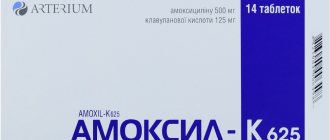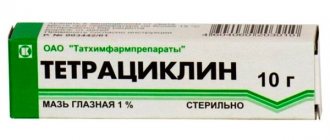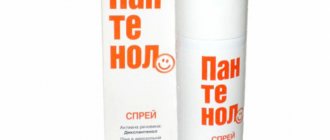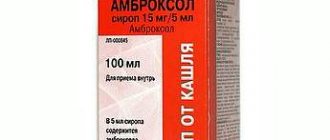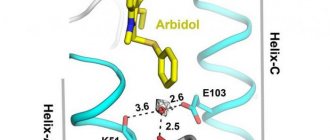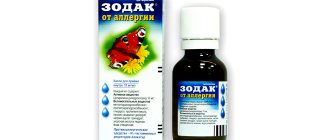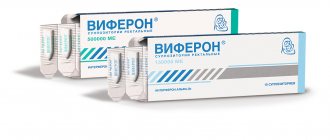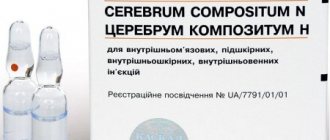Compound
- One gram of Viferon ointment for local and external use contains 40,000 IU of interferon alfa-2b as an active component, as well as 0.002 g of alpha-tocopherol acetate and a number of other auxiliary ingredients.
- One rectal suppository Viferon-1 contains 150,000 IU of interferon alpha-2b as an active component, 0.055 g of alpha-tocopherol acetate, 0.015 g of ascorbic acid (acidum ascorbinicum) and a number of other auxiliary ingredients.
- One rectal suppository Viferon-2 contains 500,000 IU of interferon alpha-2b as an active component, 0.055 g of alpha-tocopherol acetate, 0.022 g of ascorbic acid and a number of other auxiliary ingredients.
- One rectal suppository Viferon-3 contains 1,000,000 IU of interferon alpha-2b as an active component, 0.055 g of alpha-tocopherol acetate, 0.022 g of ascorbic acid and a number of other auxiliary ingredients.
- The composition of Viferon-4 includes 3,000,000 IU of interferon alpha-2b as an active component, 0.055 g of alpha-tocopherol acetate, 0.022 g of ascorbic acid and a number of other auxiliary ingredients.
- One gram of Viferon for local and external use contains 36,000 IU of interferon alpha-2b as an active component, as well as 0.055 g of alpha-tocopherol acetate and a number of other auxiliary ingredients.
Release form
The drug has three dosage forms: Viferon suppositories 150,000 IU / 500,000 IU / 1,000,000 IU and 3,000,000 IU, ointment and gel.
Viferon gel is an opaque homogeneous substance of grayish-white color.
The ointment is a viscous homogeneous mass with a characteristic lanolin odor. The color of the ointment can vary from yellowish-white to yellow.
Viferon suppositories are bullet-shaped, their consistency is uniform, and their color is white with a yellowish tint. Heterogeneity in the cutting areas is allowed. There may also be a funnel-shaped recess.
Price in pharmacies in Moscow, St. Petersburg, regions
The cost of the dosage form depends on the region and region of sale of the product. The price is also influenced by the manufacturing company and the pharmacy chain.
| Region, region | Dosage, form | Price |
| Moscow, Moscow region | 150 thousand IU | from 180 to 330 rub. |
| Moscow, Moscow region | 500 thousand IU | 50-480 rub. |
| Moscow, Moscow region | 3 million IU | 603-1100 rub. |
| Moscow, Moscow region | 1 million IU | 73-1045 rub. |
| Saint Petersburg | 150 thousand IU | 245-575 rub. |
| Saint Petersburg | 500 thousand IU | 339-456 rub. |
| Saint Petersburg | 1 million IU | 455-586 rub. |
| Saint Petersburg | 3 million IU | 532-1086 rub. |
| St. Petersburg (suburbs) | ointment, 12 g | 149-189 rub. |
| Leningrad region | 150 thousand IU | 230-575 rub. |
| Leningrad region | 500 thousand IU | 339-456 rub. |
| Novgorod region | gel, 12 g | 16-154 rub. |
Before using Viferon rectal suppositories, you should consult with your doctor and carefully study the instructions for use related to the dosage for adults and the presence of contraindications to the drug.
Article design: Oleg Lozinsky
pharmachologic effect
The drug has a pronounced antiviral, antiproliferative and immunomodulatory effect.
The combination of IFN-α2b with antioxidants enhances the antiviral activity of the active substance of the drug, its regulating effect on the immune system and, in particular, on T- and B-cells (lymphocytes developing from prethymocytes in the thymus), normalizes the concentration of immunoglobulin E .
Thanks to such a combination of components, it is also possible to eliminate the likelihood of the patient developing adverse reactions that occur when interferon drugs are administered parenterally, and to normalize the functioning of the endogenous (internal) interferon system.
The use of Viferon for the treatment and prevention of viral infections makes it possible to significantly reduce the doses of hormonal medications and antibiotics (in some cases, it is possible to avoid prescribing these medications altogether).
In addition, the use of the drug can reduce the severity of the toxic effects of antibacterial or hormonal therapy.
It is also very important that neutralizing antibodies to the IFN-α2b included in the drug are not formed in the patient even with long-term use of Viferon.
Side effects
Side effects when using Interferon alfa most often occur in forms other than suppository - in the form of injections, ointments, drops, enemas.
A common reaction is individual intolerance
Individual intolerance to the main active substance or components of the drugs is the most common reaction. It should be borne in mind that even in the form of suppositories, the drug can cause side effects characteristic of Inferon:
- A disorder of the urinary system is a disorder of the kidneys.
- Impaired visual acuity, pain and burning in the eyeballs, disruption of the optic nerves.
- Dysfunction of the central nervous system - headache, depression, weakness, dizziness, causeless anxiety, sleep disturbance, muscle weakness, trimmer, confusion, aggressive manifestations, euphoria.
- Malfunction of the digestive system - lack of appetite, nausea, vomiting, diarrhea, constipation, dry mouth, liver problems, flatulence.
- Malfunction of the circulatory system - arrhythmia, heart pain, tachycardia, sudden jumps in blood pressure.
- Allergic reactions - skin rashes, hair loss and brittleness, swelling when using the drug topically.
- Manifestations similar to influenza - fever, chills, aching joints, muscle cramps.
- Problems with the respiratory system – cough, chest pain, shortness of breath.
- Disorders of the thyroid gland.
The use of Interferon alfa in the form of suppositories reduces the occurrence of side effects and reduces them to individual intolerance to the main active ingredient of the drug or its components. Taking the medicine under the supervision of a doctor will help you quickly recognize the side effects it causes.
Pharmacodynamics and pharmacokinetics
Alpha interferon belongs to the group of water-soluble proteins . Its mechanism of action includes:
- direct antiviral effect (it is effective against viruses that cause influenza, herpes, hepatitis, etc.);
- antibacterial (bacteriostatic) effect against mixed infections;
- restoration of the function of the endogenous (internal) interferon system;
- stimulating factors that improve antibody production;
- increasing the body's resistance to various types of infections.
The antibacterial activity of the substance is determined by its ability to increase the cytotoxic activity of lymphocyte cells and stimulate the phagocytic activity of macrophages .
IFN-α2b has an antiproliferative effect when involving both cell cultures and xenografts malignant tumors and in laboratory animals.
IFN-α2b suppresses viral genome replication. By binding to specific receptors on cell membranes, interferon alpha initiates a certain sequence of complex reactions inside the cell, including the induction of certain enzymes .
The membrane-stabilizing, regenerating and anti-inflammatory effects that develop with the use of Viferon are due to the activity of substances included in the drug that have a powerful antioxidant effect - alpha-tocopherol acetate and ascorbic acid .
After parenteral administration of the drug, the concentration of interferon alpha in blood plasma reaches maximum values within 3-12 hours.
When IFN-α2b is administered vaginally or rectally, the substance is absorbed through the mucous membrane, penetrates into adjacent tissues and the lymphatic system, thereby exerting a systemic effect. And due to its ability to partially bind to mucosal cells, IFN-α2b acts locally.
The use of rectal suppositories Viferon increases the circulation time of interferon in the circulatory system (when IFN-α2b drugs are administered into a muscle or vein, this pharmacokinetic indicator is significantly less).
The level of serum interferon decreases approximately twelve hours after taking Viferon, which suggests the need for repeated administration.
Interferon alpha is excreted from the body primarily through renal catabolism . Metabolization in the liver and excretion in bile are less significant routes of elimination. Interferon alpha is partially eliminated unchanged through the kidneys.
The substance does not cumulate (do not accumulate) in various tissues of the body.
Indications for use of Viferon: what are suppositories, ointment and gel for?
Indications for use of gel and ointment
acute respiratory infections (including acute respiratory infections) and recurrent false croup ( stenotic laryngotracheobronchitis in children .
The ointment is recommended for the treatment of lesions of the skin and mucous membranes caused by various viruses (in particular, for the treatment of lesions caused by the activity of papillomavirus and the activity of virions belonging to the herpesvirus ).
In combination with other therapeutic measures, the drug in the form of an ointment can be used to treat respiratory diseases in children over one year of age.
Indications for the use of suppositories, what they are prescribed for
Viferon in the form of suppositories is prescribed as one of the components of complex therapy:
- for the treatment of infectious and inflammatory diseases in children (the drug is approved for use in newborns and premature infants with a gestation period of more than 34 weeks).
- For chronic viral hepatitis B and D in adults and children (as a rule, the drug is used in combination with plasmacytophoresis ).
- For chronic hepatitis of viral etiology, complicated by cirrhosis of the liver .
- Pregnant women who have been diagnosed with urogenital infections , as well as if pregnant women have herpetic infections of the mucous membranes and skin.
- For influenza , acute respiratory infections and acute respiratory viral infections in adults (including acute respiratory viral infections complicated by a bacterial infection).
Before using Viferon, consultation with your doctor is required.
Instructions for use of Viferon
Viferon ointment, instructions for use
In this dosage form, the drug is used as a local and external remedy.
A small amount of ointment is distributed in a thin layer on the affected areas of the skin and mucous membranes three to four times a day, and then gently rubbed in. The course of treatment usually lasts no more than a week.
Gel Viferon, instructions for use
The gel is intended for topical use. It can also be used in combination with other drugs.
The gel is used to prevent acute respiratory diseases and recurrent Croup syndrome ( stenotic laryngitis ) in children. Applying the product to a tampon, it is used to treat the child’s tonsils three times a day for three months.
Courses should be repeated twice a year.
Using the gel for infants for preventive purposes can reduce the likelihood of a child developing ARVI , which is especially important during periods of epidemics. To do this, a small amount of gel is applied to the previously dried mucous membrane of the nasal cavity.
For medicinal purposes, the tonsils are treated up to five times a day until the acute phase of the disease ends. Further treatment involves applying the drug three times a day for three weeks.
herpes virus infection in adult patients . It is recommended to start therapy for different localizations of the pathological process as early as possible.
Optimally, while the disease occurs in a latent form (hidden for clinical recognition) and makes itself felt by the episodic appearance of precursors.
The lesion must be treated four to seven times a day. The duration of treatment is from three to five days. If necessary, a repeat course may be prescribed.
Viferon candles, instructions for use
Suppositories are used rectally in combination with other medications prescribed for a specific disease in the form of tablets, powders or injections.
For adult patients with chronic viral hepatitis Viferon-4 is usually prescribed , the dose of the active substance in which is 3,000,000 IU. Treatment involves the administration of suppositories, one twice a day, for ten days.
In the future, it is enough to administer them three times a week. The course of treatment varies depending on the nature of the course and severity of the disease and ranges from six months to a year.
When the body is affected by urogenital infections , and in pregnant women also with primary and recurrent herpetic infections , Viferon-2 suppositories containing the active substance 500,000 IU are recommended for treatment.
Suppositories are administered one at a time twice a day. The duration of the course varies from five to ten days. It is repeated if necessary.
For the treatment of infection caused by the herpes virus , Viferon-3 , in which the dose of the active substance is 1,000,000 IU. Suppositories are administered one at a time twice a day, maintaining twelve-hour intervals between administrations.
The duration of the course is 10 days. In case of relapse, the duration of therapy is determined by the attending physician (it is considered optimal to start treatment at the very beginning of the appearance of its first signs).
For preventive purposes, it is recommended to repeat the course of treatment every four weeks.
For the treatment of acute respiratory infections and influenza for adults, suppositories are prescribed in a dosage of 500 thousand IU. They are placed one at a time twice a day, maintaining equal periods of time between administrations.
Instructions for using candles for children
For the treatment of newborns and premature infants whose gestation period is more than 34 weeks, in combination with specific therapy prescribed for a specific infectious disease, it is recommended to use Viferon 150,000 IU suppositories.
The course involves the administration of one suppository for five days twice a day at regular intervals.
Premature infants whose gestational age is less than 34 weeks are prescribed one Viferon 150,000 IU suppository three times a day for five days.
For children, including newborns and premature infants, with influenza , ARVI , pneumonia , meningitis , enterovirus , the patient is given one or two courses of therapy; to treat an infection caused by the herpes virus , as a rule, two courses are required; for cytomegalovirus infection and infections caused by mycoplasmas and fungi of the genus Candida, as well as for sepsis , two or three courses are required.
There are five-day intervals between courses.
The instructions for suppositories for infants recommend prescribing Viferon in the following dosages:
- infants up to 6 months – from 300 to 500 thousand IU per day;
- infants from 6 to 12 months to 1 year – 500 thousand IU per day.
Children over one year of age are prescribed 300 thousand IU per 1 sq. m of body surface area per day, and for children over seven years of age - 500 IU.
The optimal pediatric therapeutic dose is calculated based on data on the severity and nature of the disease in the child.
The daily dose must be divided into two doses, maintaining equal time intervals between them. During the first ten days, treatment involves daily administration of suppositories, then suppositories are placed three times a week. The duration of the course is from six months to one year.
Children who have been diagnosed with a chronic form of hepatitis with a pronounced degree of activity and the presence of liver cirrhosis should be administered one suppository twice a day for two weeks before the procedure of plasmacytophoresis or hemosorption .
For children under seven years of age, a dosage of 150 thousand IU is recommended, for children over seven years of age - a dosage of 500 thousand IU.
How to give a candle to a baby?
Before administering the suppository, the infant is placed on his side on oilcloth, while pressing his legs towards his stomach. It is best to place suppositories after bowel movements.
To make it easier to administer, Viferon baby suppositories can be cut in half and/or a little baby cream or Vaseline oil can be dropped on it.
Then you need to spread the child’s buttocks with your fingers, put a candle and squeeze the buttocks for a while, while fixing the child.
special instructions
Many people are interested in whether Viferon injections, drops or tablets exist. The answer to this question is negative.
This is explained by the fact that protein molecules entering the digestive tract are exposed to various secretory fluids and enzymes , and since the active substance of Viferon IFN-α2b is a protein, these enzymes will have a similar effect on it.
Thus, taking interferon alpha in the form of tablets will not give the expected therapeutic effect and will simply be impractical.
As for injections, Viferon is not administered intravenously, since in this dosage form interferon can provoke serious adverse reactions from various organs and organ systems.
When developing the drug Viferon, Feron company specialists set the main goal of creating a safe drug for the treatment of viral infections in all groups of patients, including newborns (including premature babies) and pregnant women. Therefore, looking for Viferon in tablets or injections in pharmacies is a waste of time.
What is the difference between Viferon and Viferon-2 and Viferon-3
Viferon suppositories are available in four versions, which are respectively called Viferon-1, 2, 3 and 4. They differ in the dose of IFN-α2b included in their composition.
- Viferon-1 is used to treat children under seven years of age and prevent viral infections in pregnant women;
- Viferon-2 - for children over seven years of age and treatment of viral infections in pregnant women;
- Viferon-3 is used to treat adult patients, as well as viral hepatitis in children;
- Viferon-4 is prescribed only to adults.
You can often find statements online that Viferon, like other interferon drugs, causes cancer. However, there is no confirmation for them. It is known that injectable forms of interferon provoke the development of a large number of adverse reactions. In contrast, Viferon is produced in the form of suppositories, ointments and gels, so the interferon included in its composition is absorbed into the mucous membranes and skin in very small quantities.
Contraindications and side effects
Viferon (tablets for children cannot always be used, unlike rectal suppositories) should not be used in case of diagnosing intolerance to the components of the composition or a tendency to such manifestations in the patient’s medical history.
In addition, there are other contraindications:
- Severe form of heart failure, angina and coronary heart disease. However, such pathologies are more often diagnosed in elderly patients, so it is important to carefully collect anamnesis.
- Internal bleeding of varying severity and origin. In most cases, the drug is not used for bleeding that occurs due to damage to the mucous membrane of the digestive tract.
- A severe form of renal failure, in which the functioning of the organ significantly deteriorates.
- Allergic dermatitis, dermatosis, eczema, exacerbation of chronic psoriasis. Typically, such conditions are considered a contraindication for the use of external dosage forms.
- Oncological pathologies in which the patient is undergoing immunosuppressant therapy. Medicines from this group artificially suppress human immunity in order to increase the effectiveness of antitumor therapy. Since Viferon has immunostimulating properties, it is better to avoid using it.
- The recovery period after suffering a myocardial infarction or stroke. However, many systemic medications can have a negative effect on the action of interferon.
Relative contraindications include skin injuries in the area where the product is supposed to be applied. In addition, ointment and gel are not applied to purulent lesions and damaged mucous membranes.
If the instructions are violated, negative reactions may develop. However, compliance with all recommendations does not exclude such a risk, which is associated with the individual characteristics of the patient’s body.
| Organs and systems | Most common complications |
| Nervous system | When using a gel or ointment, disorders of the nervous system develop quite rarely. However, when using suppositories, dizziness, headache and sleep disturbances are possible. Gradually, the patient becomes irritable, performance decreases, weakness and fatigue are noted, even when performing ordinary household manipulations. As a rule, the manifestations disappear after stopping the use of the drug and do not require special treatment. |
| Heart and blood vessels | Tachycardia is considered a common complication when using suppositories and almost always occurs in patients who suffer from pathologies of the heart and blood vessels. Sometimes there is a change in blood pressure, but the numbers quickly normalize after stopping the use of the drug. |
| Digestive tract | Loss of appetite and nausea are considered the most common manifestations. As the condition progresses, pain in the stomach, flatulence, bloating and upset stool appear. Lack of treatment can lead to worsening symptoms and development of dehydration. |
| Skin | Allergies appear more often when using external dosage forms, but can also develop when using suppositories. In this case, a rash appears on the skin, accompanied by severe itching and burning. Scratching the lesions certainly leads to deterioration of the skin condition and increases the risk of infection as a result of microtrauma. |
The severity of negative reactions depends on the individual patient. If complications occur, you should stop using the product and consult a doctor.
Viferon's analogs
Level 4 ATC code matches:
Roferon A
Genfaxon
Inferon
Lipoferon
Laifferon
Intron A
Betaferon
Grippferon
Ingaron
Alfarekin
Laferon
PegIntron
Pegasis
Interlock
Interferon
Nazoferon
Infagel
Reaferon-Lipint
Reaferon-ES-Lipint
Reaferon-EC
When a doctor prescribes a particular drug (and especially if the drug is expensive, such as Viferon), most patients begin to look for what can replace this drug and find cheaper analogues.
Analogues of Viferon suppositories are the drugs Vitaferon , Genferon , Laferobion , Laferon . Prices for analogues in Ukrainian pharmacies start from approximately 60 UAH.
Anaferon or Viferon - which is better?
Trying to figure out what the difference is between these drugs, we can conclude that they all have similar pharmacological effects. The difference between Viferon and Anaferon is that the latter is a homeopathic remedy and is available in the form of sublingual tablets.
Which is better: Kipferon or Viferon?
Kipferon is available in the form of suppositories for rectal and intravaginal use.
Which is better: Grippferon or Viferon?
As for Grippferon , it is available in the form of drops and spray for intranasal use.
The decision about which of the listed drugs should be prescribed in a particular case is made by the doctor.
Viferon for children
Instructions for children for Viferon suppositories permit the use of all dosage forms of the drug in pediatrics. At the same time, Viferon ointment, gel and suppositories for children can be prescribed from birth.
For the treatment and prevention of viral infections, children are prescribed Viferon-1 and Viferon-2 suppositories, the dosage of the active substance in which is 150,000 and 500,000 IU, respectively.
Suppositories for children 150,000 and 500,000 IU can be prescribed in combination with antibacterial drugs (for example, for chickenpox , especially when the disease is severe and is accompanied by pronounced symptoms of intoxication of the body and secondary pyoderma ).
The use of Viferon in etiotropic therapy in combination with drops, children's suppositories for fever, tablets or injections can reduce the viral load on the child's body, stop viremia, and also reduce the risk of developing various types of complications and adverse reactions.
Studies have shown that intranasal use of ointment for preventive purposes for newborns and young children allows you to prepare a child for preschool. All children belonged to the group of frequently ill children, however, after entering kindergarten, 41% of them did not get sick in the first three and a half months.
Reviews of Viferon suppositories for children indicate that over time, against the background of Viferon rehabilitation, all children from the control group showed a decrease in morbidity.
How often can you light candles for children?
In accordance with the standard treatment regimen for acute respiratory viral diseases, Viferon is prescribed as part of complex therapy. The course of its use is from five to ten days.
As a rule, the patient requires one or two courses every six months or a year. However, on the recommendation of a doctor, their more frequent repetition is allowed.
When using the drug, addiction to stimulation of endogenous interferon does not develop.
Interaction with other medications
Viferon suppositories combine well with any medications. All tandems with drugs belonging to the group of antibiotics and all chemicals that can treat the above diseases are acceptable.
It is possible to use the drug in complex therapy along with antibacterial and immunosuppressive drugs, glucocorticosteroids and interferon inducers.
The simultaneous use of Viferon suppositories with other rectal preparations is unacceptable if the latter contain oily ingredients (sea buckthorn or pumpkin oil). These substances create an obstacle to the penetration of interferon into the blood and significantly reduce the effectiveness of its therapeutic effect.
Viferon during pregnancy
Viferon ointment and gel are characterized by low systemic adsorption, therefore both of these dosage forms are approved for use in pregnant women (at any stage of pregnancy) and lactating women.
The use of Viferon suppositories for pregnant women is allowed from 14 weeks. But during breastfeeding, candles can be used without any restrictions.
Viferon-2 suppositories are prescribed during pregnancy with a dosage of 500 thousand IU. They are recommended to be administered one twice a day at regular intervals every day for ten days. Over the next ten days, it is enough to administer one suppository twice a week twice a day.
After four weeks, a preventive course is necessary.
For prevention during pregnancy, Viferon suppositories are prescribed in a dosage of 150 thousand IU. They are administered one at a time twice a day for five days. For preventive purposes, courses are repeated every four weeks until the birth of the child.
In general, women are recommended to treat gynecological infections during the period of planning a child, before pregnancy. Genferon are usually used .
Here the question naturally arises, which is better: Genferon or Viferon? Unlike Viferon, Genferon suppositories are inserted not into the rectum, but into the vagina, acting not systemically, but locally.
Thus, they can effectively (reviews suggest that sometimes even more effective than Viferon) treat urogenital infections , however, for viral infections localized outside the genital area, it is not advisable to prescribe the drug.
Reviews about Viferon
Reviews about Viferon and, in particular, reviews from doctors about suppositories are mostly positive. The drug in all its dosage forms is widely used both for the treatment of adults and pediatrics.
Ointment and gel for children are effective means for treating viral infections.
Reviews of Viferon ointment, as well as the gel, allow us to conclude that their use is advisable for the prevention of acute respiratory infections , acute respiratory viral infections and influenza in both adults and children, since this makes it possible to prevent various childhood diseases and increase the body’s natural immunity.
Viferon is also often used as an ointment for warts and an ointment for papillomas .
Reviews of Viferon suppositories for children also indicate that the product copes well with viruses, alleviates the course of the disease, and also reduces the severity of the toxic effects that occur after taking antibiotics.
Reviews of Viferon suppositories during pregnancy eloquently indicate that this drug is a timely first aid for the body of a woman who is preparing to become a mother.
The immune system of pregnant women is often weakened, and any infection can seriously harm the developing baby. Viferon belongs to the category of safe drugs, and not only kills the infection, but also strengthens the body's defenses.
Reviews from doctors and patients
Reviews from medical workers are varied. Some experts assess the effectiveness of the drug positively. They note the effectiveness of Viferon in the treatment of diseases such as dental herpes, ARVI, gynecological infections, viral lesions of the skin and mucous membranes.
Among the advantages of the drug, doctors call its ability to quickly cope with viruses, support immunity, activating the production of microphages (immune cells that kill the virus) in the body. In addition, experts pay attention to the ability of the active component of the drug to create an obstacle to the adaptability of the virus to interferon.
Among the opponents of Viferon, the main argument is its complete uselessness in treatment. This group of doctors notes that the therapeutic effect of the drug has not been proven, and they are not satisfied with the clinical result. At a fairly high cost, there is no effectiveness.
Nevertheless, Viferon is one of the most prescribed drugs for the complex treatment of viral and infectious pathologies. This is evidenced by patient reviews.
Most of those who used the drug are satisfied with the results of therapy. This is especially true for parents who used Viferon to treat their children. They note ease of use (candles with a minimum dosage are small in size) and high efficiency. Some parents are satisfied with the affordability of the drug and the ability to purchase it without a doctor’s prescription.
Among adults, there are a significant number of respondents who note the mild, gentle effect of Viferon on the body. In addition, among the positive aspects, the rapid onset of the therapeutic effect is indicated (within 2-3 days). Many are pleased with the absence of adverse reactions and the minimum of contraindications for its use.
Viferon price
How much does Viferon cost in Russia?
The price of Viferon suppositories for children varies from 200-400 rubles, depending on the content of the active substance. Thus, suppositories of 150,000 IU cost approximately 200-300 rubles, and children’s suppositories with a dosage of IFN-α2b of 500,000 IU cost 300-400 rubles.
The average price of Viferon 1000000 IU candles is 500-600 rubles, the price of Viferon 3000000 IU is 900-1000 rubles.
The price of Viferon gel and ointment is about 200 rubles.
The drug is not available in the form of tablets, drops or injection solution.
How much does Viferon cost in Ukraine?
Antiviral suppositories for children Viferon-1 cost about 150 UAH, Viferon-2 suppositories 500,000 IU can be purchased for an average of 200 UAH per package, the average cost of Viferon-3 suppositories is 400 UAH, Viferon-4 can be purchased for approximately 600 UAH.
At the same time, buying gel, ointment for warts or suppositories in pharmacies in the capital can be somewhat more expensive than, for example, in pharmacies in Kharkov.
- Online pharmacies in RussiaRussia
- Online pharmacies in KazakhstanKazakhstan
ZdravCity
- Viferon supp.
rect. 500,000 IU No. 10 LLC Feron 437 rub. order - Viferon supp. rect. 150,000 IU No. 10 LLC Feron
RUB 312 order
- Viferon sup.rect. 3,000,000 IU No. 10 LLC Feron
1050 rub. order
- Viferon ointment 40 thousand. IU/g 12g LLC Feron
RUB 207 order
- Viferon gel for local use. and external approx. 36000 IU/ml 12g 10ml Feron LLC
RUB 196 order
Pharmacy Dialogue
- Viferon (No. 2 sup. 500.000 IU No. 10) Feron
RUR 469 order
- Viferon (No. 1 sup. 150.000 IU No. 10) Feron
RUB 274 order
- Viferon (No. 4 sup. 3,000,000 ME No. 10) Feron
1125 rub. order
- Viferon (No. 3 sup. 1,000,000 ME No. 10) Feron
RUB 629 order
- Viferon gel (tube 36 thousand IU 12g) Feron
RUB 205 order
show more
Conditions for dispensing from pharmacies, price of the drug
Viferon (tablets for children can be prescribed in the absence of the original medicine) today can be purchased in pharmacies without a prescription from a doctor. Ointment and gel cost approximately 200-250 rubles. depending on the region of distribution.
The cost of candles differs, which is due to different dosages. The average price for 10 pieces ranges from 300-600 rubles. The shelf life of medications is 2 years for suppositories and 1 year for ointments and gels. Using the product after the expiration date is strictly contraindicated. The production date of the medicine is indicated on the packaging.


